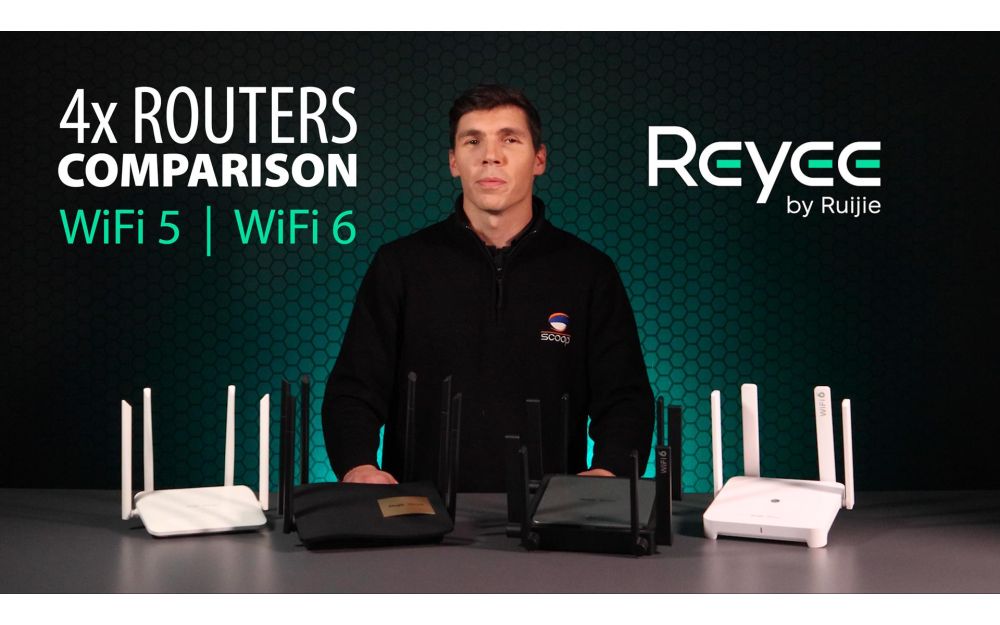Reyee EW-Series Routers
Reyee is growing globally as a brand and for good reason. We'd like to outline what to expect when buying a Reyee router and how they compare with each other.
The range includes both WiFi 5 and WiFi 6 devices with push-button mesh technology. They support everything you would expect from a modern entry-level router. What really sets them apart is that they can be fully managed in the cloud, at no cost to you.
Ruijie Cloud
Ruijie Cloud is a completely free service for managing all types of Reyee products via their mobile app or web browser. This makes remotely managing devices easier than ever, plus an attractive proposition for ISP’s and system integrators.
Once connected to the internet, simply scan the QR code on the app or directly connect the routers’ wifi to provision. The cloud supports multiple sites and can be scaled to any size, which could be shared with engineers or technicians. Included in the app is a host of tools that can be used to optimize and diagnose all aspects of the client's network. From global configuration across devices to simple speed tests and a load of other useful features.
With Reyee you are getting enterprise-level management controls at the price of just an entry-level device.
If the cloud is not for you, they can be configured stand-alone via web UI and can even act as hardware controllers to other Reyee devices operating on the same network.

We compared four routers in the EW-Series
The RG-EW1200F is the entry-level AC Standard model and has fast ethernet ports with four 5dBi antennas. It is based on Wave 2 and supports MU-MIMO topping out at 867Mbps. This is the ‘go-to’ router for any sub 100Mbps connection while providing the most cost-effective solution with great wifi performance.
The RG-EW1200G is the next step up. It also features a Wifi 5 radio but this model has Gigabit ports and provides more antennas with slightly higher gain at 6dBi. The upgraded antenna design makes it better for larger areas or for improved wall penetration. The ports benefit users who require a high-performance LAN or have Gigabit internet connections.
The RG-EW1800GX is the first WiFi 6 offering from Reyee. It has gigabit Ethernet ports, WiFi 6 on both radios and 4x4 MU-MIMO to achieve up to 1800mbps maximum data rate. If you are looking to take advantage of the Wifi 6 standard or just looking to future-proof your home network this is a great entry point that doesn’t break the bank. Besides the higher overall performance connecting to multiple devices, WiFi 6 is generally more capable of maintaining higher data rates at longer distances. Just like the RG-EW1200G, this router is capable of Gigabit on both LAN and WAN.
The RG-EW3200GX is the powerhouse of the range. It supports dual-band AX and has a massive antenna array capable of 4x4 MU-MIMO and a maximum data rate of 3200Mbps. This device provides the best performance and coverage of the lot. It is designed for homes or small businesses that require high connection concurrency at the best speeds. If you are looking for the best and don’t care about budget, then this is the router for you.
Push-Button Mesh
All Reyee home routers feature push-button mesh technology to easily extend wireless networks and eliminate dead spots. Simply hold down the mesh button while powering on the device and it will automatically receive the configuration from the primary router. Alternatively, they can be configured in access point mode which essentially allows them to work as a cabled extender under a single SSID.
Testing
After reading through the specs, we decided to do some real-world testing to find out exactly how they compare with each other. Configuration-wise, they offer exactly the same feature set and the UI is identical. The main three areas we wanted to look at were WAN speed, Wifi coverage and actual data throughput.
We started off with WAN speed. We cabled into the router and ran Iperf over the Ethernet ports. All devices support hardware offload which is disabled by default, so we decided to test both configurations to give us an idea of how well each performed. With hardware offload disabled we could see the 1200G topped out at around 800mbps and, as expected, this increased with the Wifi 6 models owing to more processing power. The 3200GX just works at Gigabit straight out of the box.

Next up was our signal test. We tested this by placing the routers in the same location on the identical channel at maximum transmitter power levels. Our client device was 15m away with a wall in between to simulate a real-world environment. As expected the 3200GX was the winner since it has more antennas. It was interesting to see that signal coverage across the rest of the range was actually very close.

Finally our Wireless throughput test. In order to get maximum real-world data to a single client, we used a Wifi 6 Macbook Pro right next to each router and ran a TCP Iperf test to a cabled server. This was done using the same channel on 80Mhz with no interference. When looking at the data we found the performance to be quite close between the WiFi 6 models. This is most likely due to limitations on the client itself since it only has two antennas. In a situation where you had multiple clients or more antennas on a single client, we would expect to see a bigger variance in performance. Despite this, we are very pleased with the results across the board.
Test result: RG-EW1200F

Test result: RG-EW1200G

Test result: RG-EW1800GX

Test result: RG-EW3200GX









